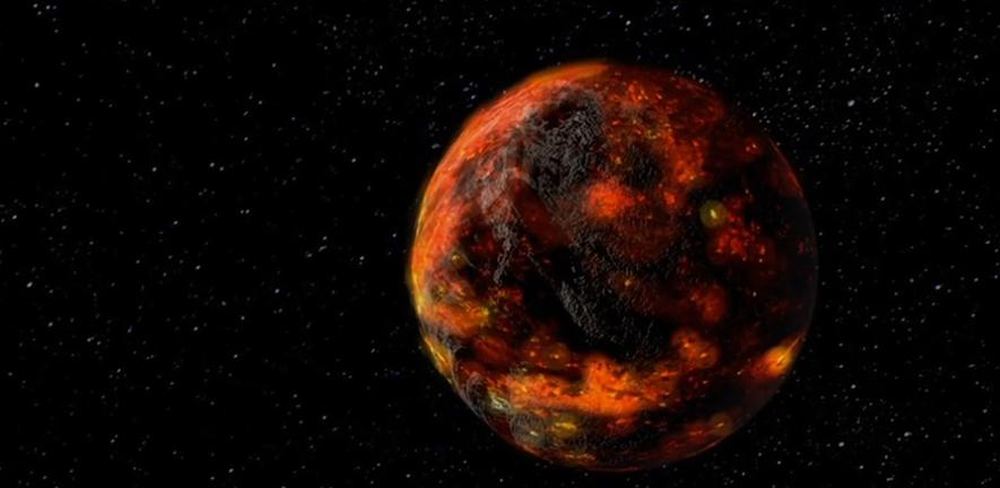Scientists’ detailed study of the Moon dates back to the Apollo missions when astronauts brought rock samples from the lunar surface back to Earth for analysis. Apollo 11 gathered samples from the lunar highland regions, the pale areas on the Moon’s surface easily seen from Earth. The highlands are made of a relatively light rock called anorthosite, which formed early in the history of the Moon, between 4.3 and 4.5 billion years ago.
There’s some mystery involved in the anorthosite formation on the Moon. The age of the anorthosite highlands doesn’t match how long it took for the Moon’s magma ocean to cool. But scientists behind a new study think they’ve solved that mystery.
Geologists are interested in lunar anorthosites because of the uncertainty surrounding their formation. Their formation involves fractional crystallization, where anorthite mineral crystals are removed from magma as they form, with lighter crystals rising to the surface. But some of the details of their formation are still unclear.
(Note: The anorthosite is the rock that forms the highlands. Anorthite is a mineral (plagioclase). So anorthosites are rocks that are very rich in anorthite.)
A collision between two protoplanets created the Moon. One of the protoplanets became the Earth, and the smaller one became the Moon. After the crash, the Moon heated up so much that the entire mantle was molten. Geologists call this a magma ocean.
When scientists studied the Apollo 11 samples from the lunar highlands, the evidence seemed to confirm that the anorthosites on the lunar highlands were formed by fractional crystallization. Light anorthite crystals rose to the top of the magma oceans comprising the highlands, and heavier crystals sank. The Highlands is more than 90% anorthite.

But there are problems with that explanation, and a pair of scientists think they have a better answer. They’ve presented their work in a paper titled “Formation of the Lunar Primary Crust From a Long-Lived Slushy Magma Ocean.” The A.G.U.’s Geophysical Letters published the paper by researchers Chloé Michaut and Jerome A. Neufeld.
“Since the Apollo era, it has been thought that the lunar crust was formed by light anorthite crystals floating at the surface of the liquid magma ocean, with heavier crystals solidifying at the ocean floor,” said co-author Chloé Michaut from Ecole normale supérieure de Lyon. “This ‘flotation’ model explains how the lunar Highlands may have formed.”
But that conclusion is based on samples from Apollo11, and present-day researchers have more tools and evidence at their disposal. Analysis of lunar meteorites and deeper analysis of the Moon’s surface contradict the earlier conclusion. The lunar anorthosites appear to be more heterogeneous instead of highly fractionated. Anorthites are spread throughout the rock, but the surface is especially rich in anorthites. These findings suggest that our understanding of the lunar magma ocean isn’t complete.
So what happened in the ancient magma ocean to create these heterogenous anorthosites in the lunar highlands?
One of the clues to what happened is the disparity between the age range in the anorthosites and how long it took the magma ocean to cool. The anorthosites are over 200 million years old, but the ocean solidified in about 100 million years.

“Given the range of ages and compositions of the anorthosites on the Moon, and what we know about how crystals settle in solidifying magma, the lunar crust must have formed through some other mechanism,” said co-author Professor Jerome Neufeld from Cambridge’s Department of Applied Mathematics and Theoretical Physics.
Michaut and Neufeld developed a mathematical model to identify this mechanism. Their model shows that it’s difficult for heavier crystals to settle to the bottom in the Moon’s lower gravity. The convective currents in the magma ocean also discourage settling. The pair of researchers found that the ocean could have formed a kind of slurry, where crystals remain suspended rather than settling or rising. They also found that there’s a critical threshold. When the crystal content in the slurry is above this threshold, the slurry becomes more viscous, and deformation slows down.
In their paper, the authors say that “On reaching this critical crystal fraction, the mixture viscosity dramatically increases which may result in a prolongated mushy magma ocean stage.”
In this scenario, the surface of the slurry cools faster than the interior. The result is the anorthite-rich crust we see in the lunar highlands and a more well-mixed, slushy interior.

“We believe it’s in this stagnant ‘lid’ that the lunar crust formed, as lightweight, anorthite-enriched melt percolated up from the convecting crystalline slurry below,” said Neufeld. “We suggest that cooling of the early magma ocean drove such vigorous convection that crystals remained suspended as a slurry, much like the crystals in a slushy machine.”
The press release goes on to say that “Enriched lunar surface rocks likely formed in magma chambers within the lid, which explains their diversity.”
This research explains the discrepancy between the age of the anorthosites and the understood length of time it took for the magma ocean to solidify. Rather than taking 100 million years to cool, the magma ocean was a slushy mix that took over 200 million years to cool, matching the age of the anorthosites in the lunar highlands.
More:
- Press Release: ‘Slushy’ magma ocean led to formation of the Moon’s crust
- Study: Formation of the Lunar Primary Crust From a Long-Lived Slushy Magma Ocean
- Universe Today: The Moon was Pummeled Even Harder by Asteroids Than it Looks

